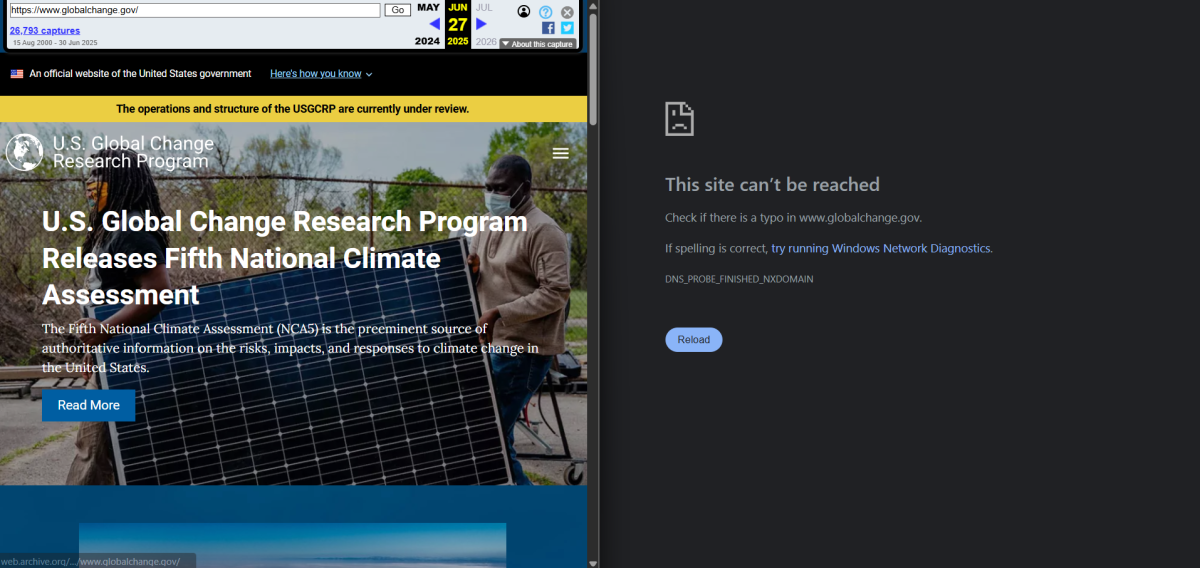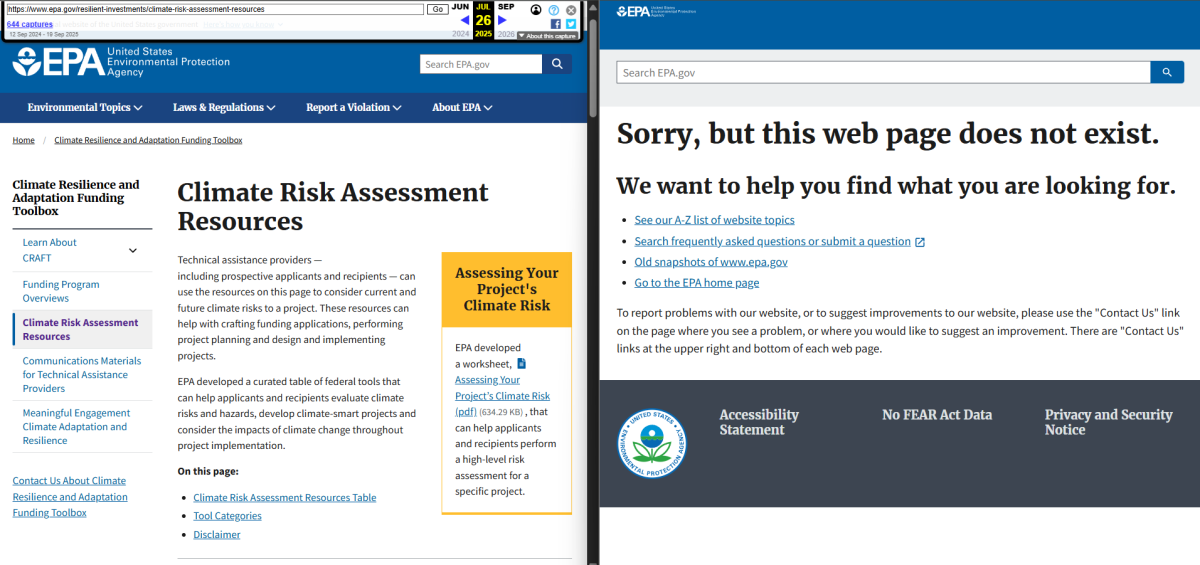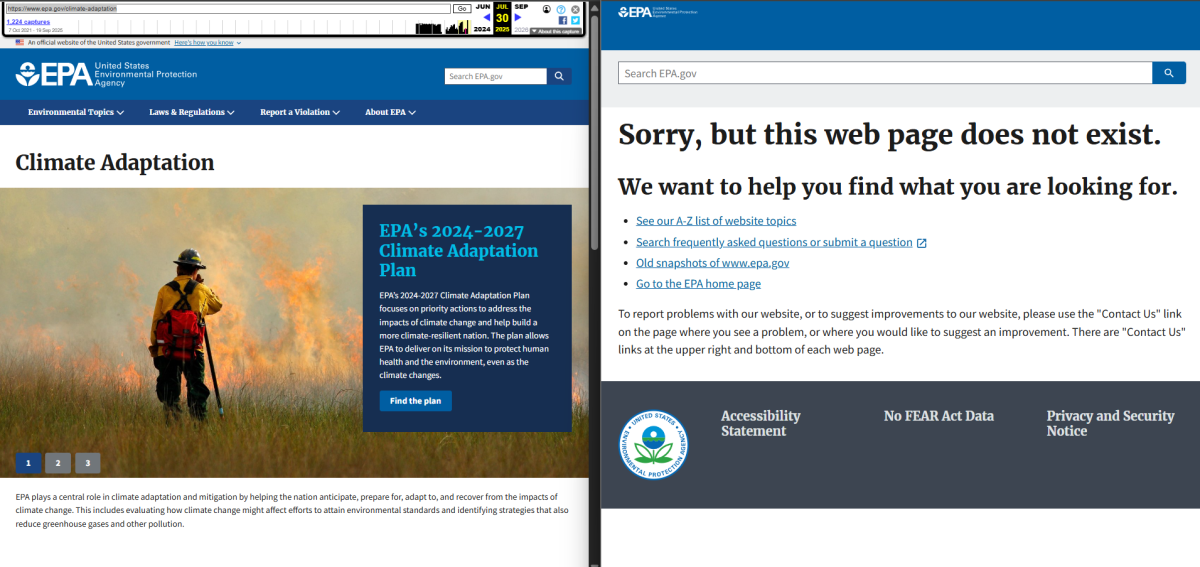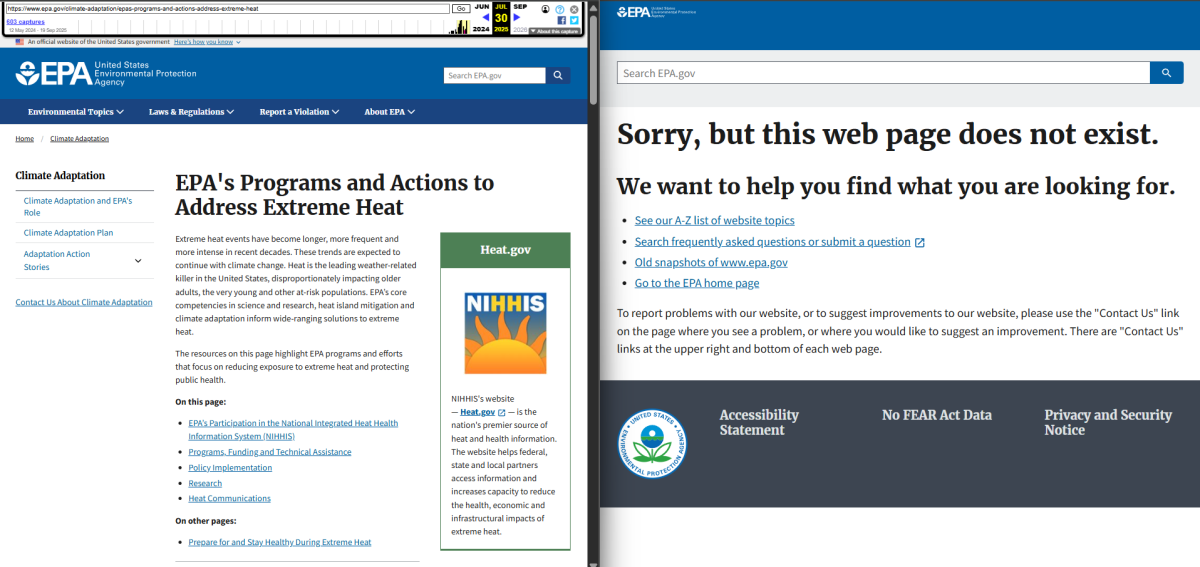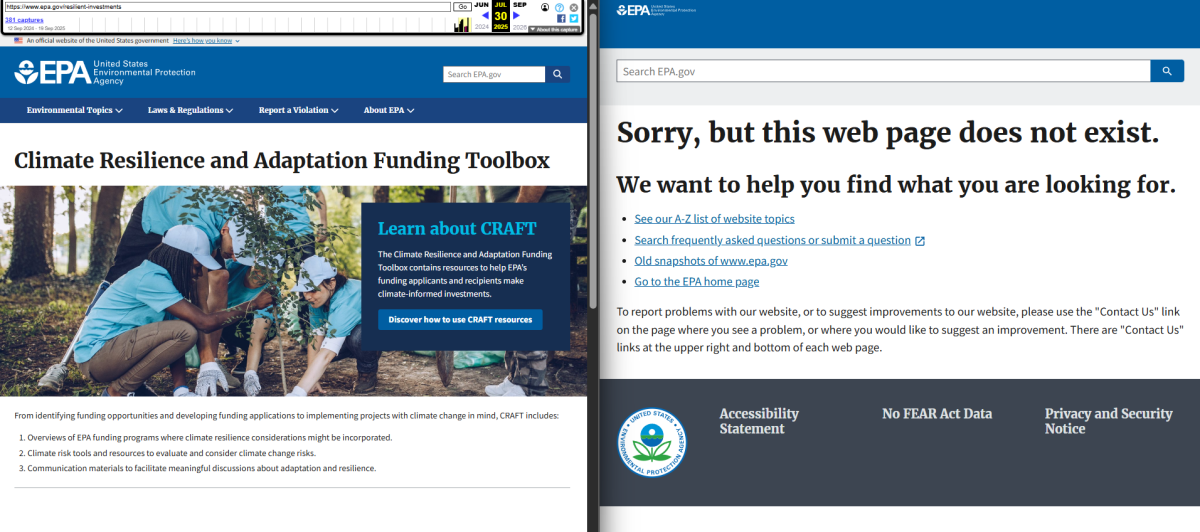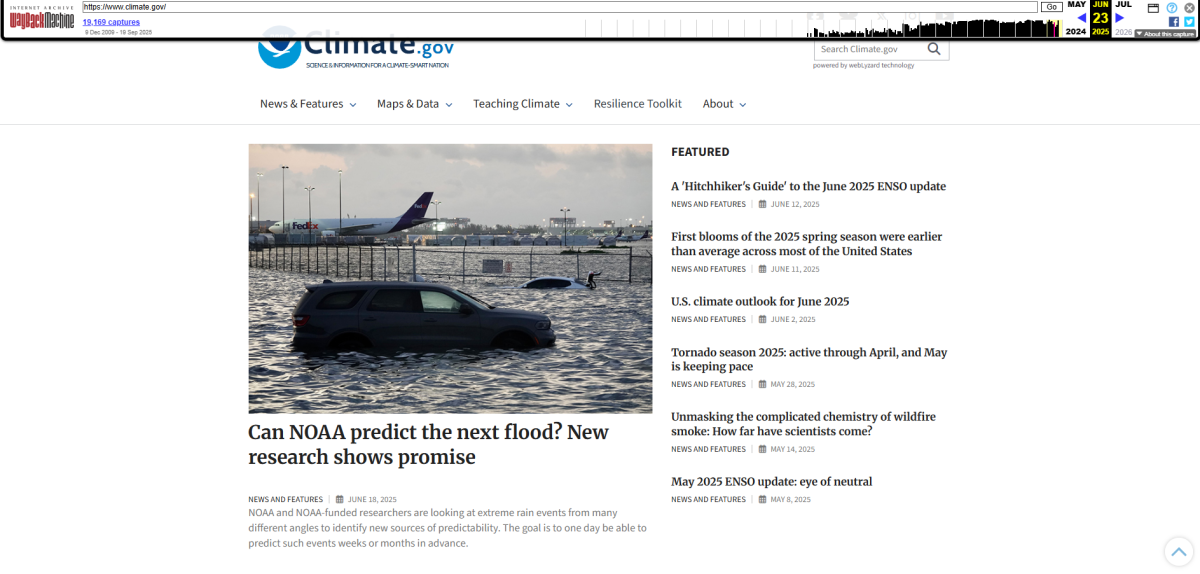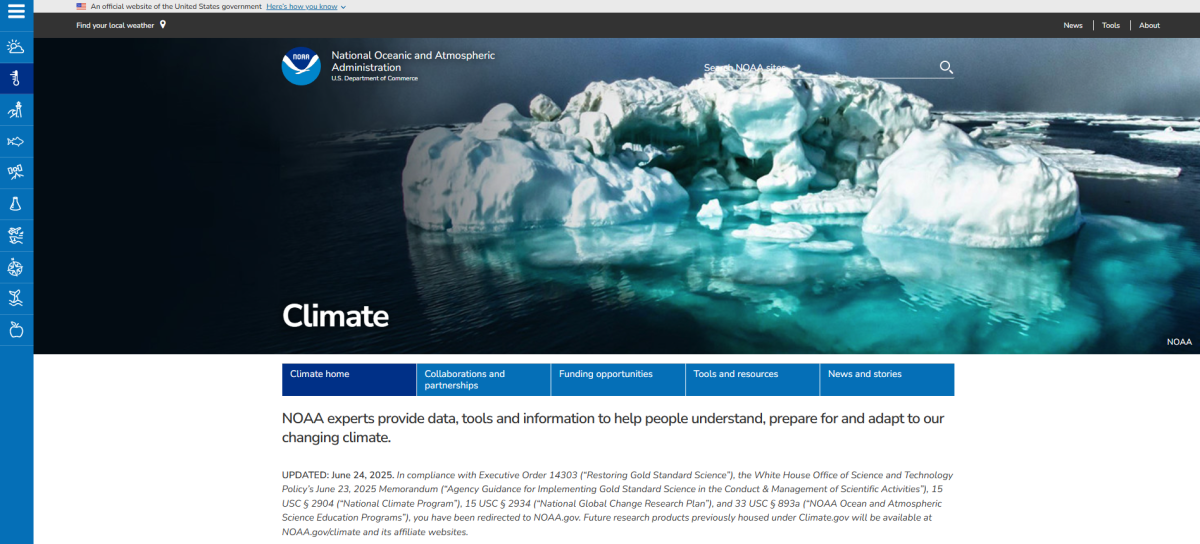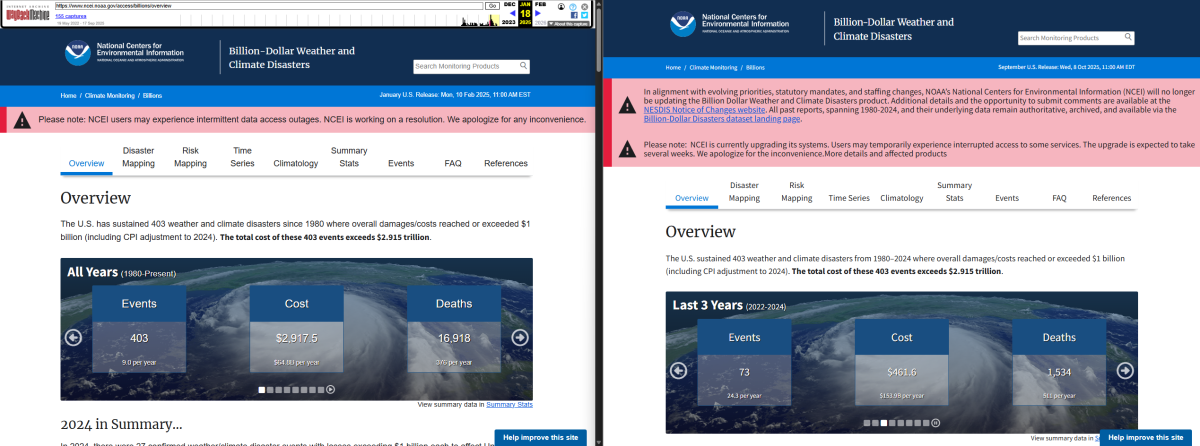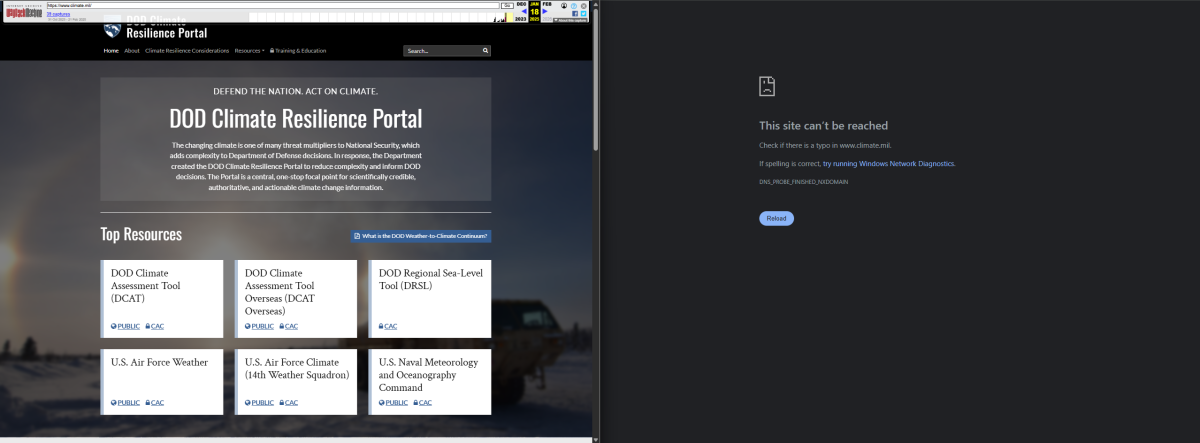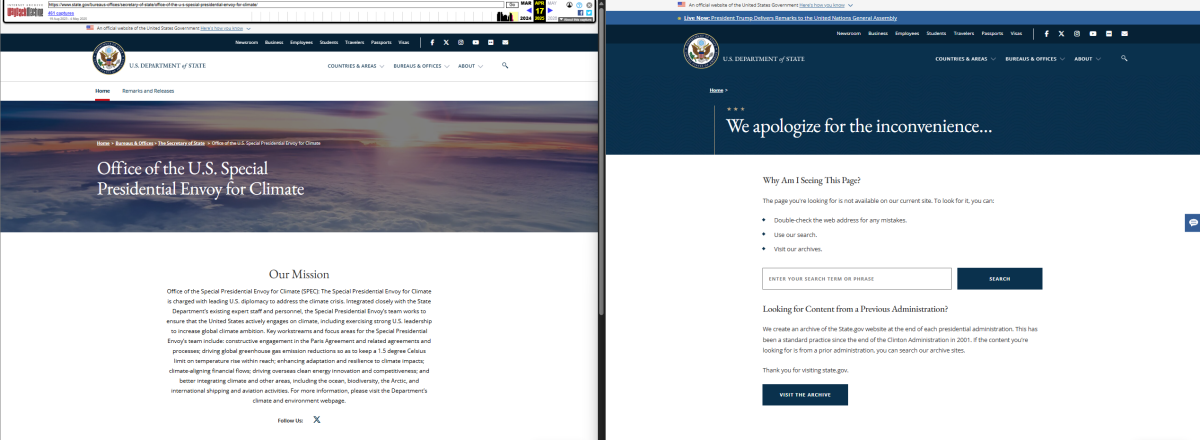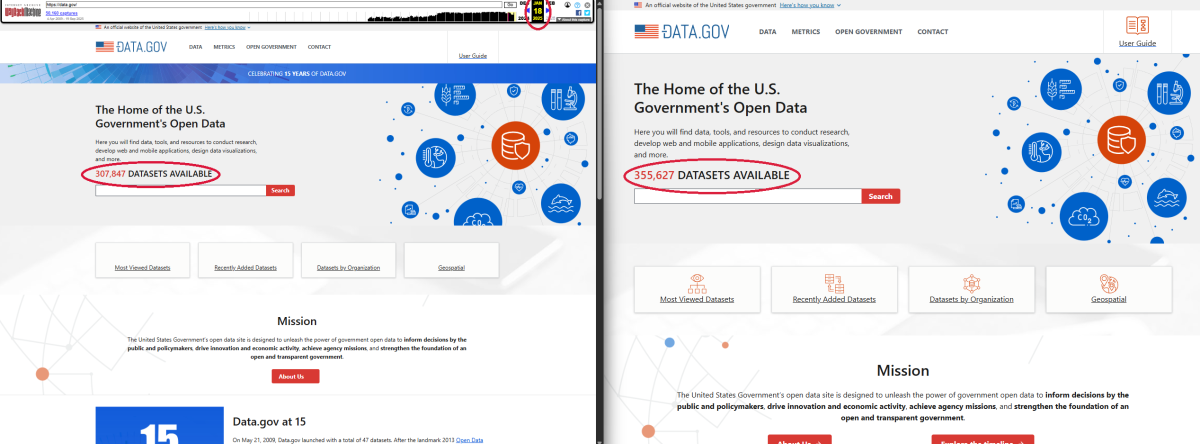Washington, D.C., September 30, 2025 - Eight months into President Donald Trump’s second term, the administration has fundamentally distorted the federal information landscape as it continues to rewrite and erase resources about climate change, environmental justice, and climate diplomacy. In a follow up to a previous posting on the administration’s first two weeks of environmental data overhaul, the National Security Archive’s Climate Change Transparency Project today publishes an update of the most recent actions the administration has taken to “disappear” climate information and what some advocates are doing to try to rescue and archive the data before it is removed from federal websites. The update also includes “before and after” screenshots of climate-related webpages deleted under the Trump administration.
In the days immediately following President Trump’s inauguration on January 20, 2025, the administration’s most glaring deletions from federal websites had more to do with the removal of environmental justice resources and Diversity, Equity, and Inclusion (DEI) language than the actual removal of climate change data—like the deletion of the Council on Environmental Quality’s Climate and Economic Justice Screening Tool (CEJST).[1] But in recent weeks and months, the White House has ramped up efforts to alter and remove critical climate resources from agency websites.
As we previously reported in February, coalitions of environmental advocacy and archivist organizations continue to scrape, preserve, and protect these critical climate and environmental data. Throughout the second Trump administration, groups like the Environmental Data and Governance Initiative (EDGI) and Public Environmental Data Partners (PEDP), working with staff from the Internet Archive’s Wayback Machine, have updated the public on massive data losses and have monitored changes to thousands of federal government webpages through online web trackers. Likewise, scientists, environmental scholars and historians continue to speak out about the administration’s climate denialism and anti-science rhetoric.[2]
This dismantling of access to public information is part of the Trump administration’s “denial by erasure” strategy which aims to “eradicate climate change references from absolutely everywhere” and that was first outlined in a Project 2025 training video.[3] Recent data erasures and alterations—such as the Department of Energy’s efforts to remove or maniputate scientific reports, and the Environmental Protection Agency’s erosion of its own regulatory powers—greatly complicate the ability of federal agencies to study, enforce, and inform the public about climate policy, and likewise inhibit public efforts to hold the government to account on environmental issues.
The biggest blow to climate data access was the June 30 removal of the National Climate Assessments (NCAs) and the shuttering of the U.S. Global Change Research Program (USGCRP) webpage, the federal website which housed the assessments.[4] (Figure 1) The Congressionally mandated NCAs are published quadrennially and involve the work of hundreds of scientists who translate complex scientific data into accessible information for the public. These reports are used widely at the state and local levels by policymakers, farmers, and businesses, and can help them prepare for the impact of heat waves, droughts, and floods.
Scientists and environmentalists first feared the assessments were at risk in April, when 400 experts working on the sixth version of the assessment were dismissed.[5] When the USGCRP website went dark at the end of June, the National Aeronautics and Space Administration (NASA) ensured the public that it would continue to host the NCA reports to comply with the statutory mandate. Days later, however, NASA walked back its statement, stating it had already complied with the requirements “by presenting its reports to Congress” and was not obligated to host the previous five reports.[6] Although the climate assessments are no longer housed on NASA’s website, they can still be found on the National Oceanic and Atmospheric Administration’s (NOAA) institutional repository[7] and on other non-governmental platforms.[8] (Figure 2)
At present, it is unclear whether work will continue on the upcoming sixth assessment (which was set to be published in early 2028) or if the report will be made available only to Congress. Even if a public-facing sixth National Climate Assessment is published, its scientific integrity could be compromised, as underscored by Energy Secretary Chris Wright’s comments that the administration will alter previously published NCAs.[9] Similarly, the scientific community has denounced a recent report from the Department of Energy’s Climate Change Working Group on the climate impacts of greenhouse gas emissions for cherry-picking scientific data and bypassing typical scientific review processes.[10]
At the time of Part I of this posting, references to climate change on the Environmental Protection Agency’s (EPA) website had been deleted, but various climate change resources had remained untouched. But this changed in August when the EPA removed webpages dedicated to climate adaptation, programs aimed at addressing extreme heat, and climate risk assessment resources. (Figures 3-6) These deletions come on the heels of EPA Administrator Lee Zeldin’s proposal to completely overhaul the independent agency’s regulatory agenda.[11] In July, Zeldin revealed a plan to rescind the agency’s landmark 2009 endangerment finding, and, more recently, to eliminate its Greenhouse Gas Reporting Program, which requires businesses to report their greenhouse gas emissions.[12] Notably, the EPA’s webpages on “Climate Change” and “Climate Change Impacts” appear to be largely unchanged since before President Trump took office. (Figures 7 and 8)
Another massive data loss came this summer when NOAA staff running Climate.gov, the website of the agency’s Climate Program office, were fired in what they called a “targeted attack.”[13] (Figure 9) The “independent, non-partisan” website published information about changing weather patterns, droughts, agricultural best practices, changes to the Earth’s atmosphere, and greenhouse gas emissions.[14] Currently, the Climate.gov domain reroutes users to NOAA.gov/climate,[15] (Figure 10) but former NOAA staff and climate.gov contributors recently announced plans to launch an independent website that will house the contents of the shuttered climate.gov.[16]
This preservation announcement comes as a welcome reprieve to scientists, environmentalists and data access specialists, but NOAA has also experienced losses to several publicly available National Centers for Environmental Information (NCEI) datasets and retired its “Billion-Dollar Weather and Climate Disasters” database.[17] (Figure 11) President Trump’s proposed budget cuts would also shut down the agency’s Mauna Loa Observatory, the longest continuously running observatory measuring carbon dioxide in the world. The site, which has collected data on atmospheric changes since 1958, is part of a larger global network of stations that monitor the atmosphere. The proposed cuts at Mauna Loa and three other stations in Alaska, American Samoa, and the South Pole would remove the “pole-to-pole” understanding of greenhouse gases now enjoyed by the United States. Experts believe these data losses, coupled with severe cuts in agency funding, will erode the “backbone” to tracking greenhouse gas emissions.[18]
NASA is also at risk for severe budget cuts next month when Congress begins Fiscal Year 2026. President Trump has proposed $6 billion in cuts to the agency, a 24% reduction in NASA’s current budget. This reduction would include funding cuts to two satellites “integral to climate science”: Orbit Carbon Observatory-2 and -3, or OCO-2 and -3. For years, these satellites have provided scientists with some of the best data available on atmospheric carbon dioxide concentrations. The retirement of OCO-2 and -3, which are currently in good condition and operate at a low cost, would “take the United States ‘out of the information-generating game’.” Notably, NASA’s “Global Climate Change” page is still accessible, although at the time of this publication a banner message at the top of the site states that the website “is going to look a little different in the coming months” as it’s moving to a “more integrated portal on science.nasa.gov.”[19] (Figure 12)
NOAA and NASA play a critical role in national security by supporting the United States defense and intelligence communities through data collection and analysis, and cuts are likely to impact critical agencies like the Department of Defense (DOD), which has already erased important climate datasets and resources from public view on its own initiative. On February 6, DOD (which has since been rebranded as the Department of War) removed its webpage on “Tackling the Climate Crisis” and with it the DOD Climate Resilience Portal. (Figure 13) This portal was a “one-stop focal point for scientifically credible, authoritative, and actionable climate change information,” including: tools for climate assessment overseas and regional sea-level rise; resources for U.S. Air Force and Navy climate services to be used for joint planning exercises; and programs to better manage DOD infrastructure using environmental data. (Figure 14) Similarly, the White House initially halted data collection by DOD’s Defense Meteorological Satellite Program, a program that has been crucial to storm and hurricane forecasting, but the Navy has since announced that it will continue sharing data with NOAA until fall 2026.[20] Earlier this year, the most recent Annual Threat Assessment, presented to Congress by Director of National Intelligence Tulsi Gabbard, omitted all mention of climate change—the first to do so in over a decade.[21]
There have also been severe cuts in federal workers dedicated to dealing with climate change. Several offices dedicated to climate work across the Executive Branch have had significant staff cuts or will have their funding cut in FY2026 and be eliminated altogether. The EPA will officially eliminate its Office of Research and Development (ORD) branch as part of a reduction in force for all ORD employees.[22] The environmental agency will also shutter its Office of Atmospheric Protection (OAP) and Office of Air Quality Planning and Standards (OAQPS).[23] OAP and OAQPS are both housed under the larger Office of Air and Radiation (OAR), which Zeldin has said will absorb much of OAP and OAQPS’s work. However, the reality is murkier given the administrator’s proposals to curb EPA’s regulatory standards.
At the State Department, Secretary of State (and National Security Advisor and Archivist of the United States) Marco Rubio announced a complete overhaul of the Department and has fired more than 1,000 employees.[24] The restructuring included deep cuts in all of State’s work on human rights, democracy, refugees and climate. Offices dedicated to climate diplomacy, multilateral negotiations, and climate aid were also gutted, chief among them the Office of Global Change and the Office of the U.S. Special Presidential Envoy for Climate.[25] At the time of this publication, the URL for the Office of Global Change is still live, but the URL for the Office of the Climate Envoy yields an error stating “We apologize for the inconvenience.” (Figures 15 and 16)
At the start of President Trump’s second term, more than 2,000 datasets disappeared from data.gov, the largest repository of U.S. government open data on the internet. Now, it appears that over 50,000 datasets have been added to the repository. (Figure 17) However, a comparison of screenshots taken before January 20 to screenshots taken at the time of this posting reveal that thousands of datasets from NOAA and the Department of Interior—along with datasets across topics like the Arctic, climatology and meteorology, ecosystem vulnerability, coastal flooding, carbon balance, and winter storms—have been removed. (Figure 18) But monitoring datasets on data.gov is complicated; sometimes datasets that are no longer listed on data.gov can live elsewhere on other federal websites. A report from 404 Media found that datasets no longer available through the portal “disproportionately” come from NOAA, NASA, the Department of Interior, Department of Energy, and the EPA, but “determining what is actually gone…is a manual task” that will take much more time.[26]
Data rescue coalitions are working feverishly to download climate data and resources before they disappear and are encouraging activists, journalists, and researchers to engage with the data. For example, EDGI’s Federal Environmental Web Tracker makes changes to federal websites publicly available and searchable.[27] Other organizations like the Data Rescue Project have built a catalog of existing public data rescue efforts to “coordinate better across initiatives,” and Harvard’s Library Innovation Lab has released its own archive of data.gov making it easier for researchers and the public to cite government information. Indeed, taxpayers are engaging with this vital data, as evidenced in a lawsuit brought forth by farmers suing the U.S. Department of Agriculture for deleting climate tools.[28]
Despite this patchwork effort, the archiving of government data on climate and the environment is expansive, and—so far—has been operating on a largely voluntary basis. EDGI co-founder Gretchen Gehrke told the Bulletin of the Atomic Scientists that rescue efforts simply can’t fill the gaps left by the administration’s erasure agenda: “Little nonprofits are not going to be sending up a satellite and collecting climate data. We are at the mercy of our government to collect this data for the public good, and if they choose not to, I don’t think there’s a lot that we can do about it.”[29]
Click on the images below to see some examples of how the Trump administration has deleted federal climate data.
Disappearing Data Part II: Figures
Figure 1. U.S. Global Change Research Program (USGCRP) website before and after screenshots. The website previously housed all previously published National Climate Assessments. (Left image is an Internet Archive Wayback Machine screenshot from June 27, 2025. Right image is a National Security Archive screenshot of the globalchange.gov URL taken on September 22, 2025).
Figure 2. National Oceanic and Atmospheric Administration Institutional Repository website (National Security Archive Screenshot taken on September 22, 2025). With the exception of the 2nd National Climate Assessment (NCA2), all published National Climate Assessments can be found on NOAA’s Institutional Repository website.
Figure 3. Environmental Protection Agency Climate Risk Assessment Resources webpage before and after screenshots. (Left image is a Wayback Machine screenshot from July 26, 2025. Right image is a National Security Archive screenshot of the page taken on September 22, 2025).
Figure 4. EPA’s Climate Adaptation webpage before and after screenshots. (Left image is a Wayback Machine screenshot from July 30, 2025. Right image is a National Security Archive screenshot of the page taken on September 22, 2025).
Figure 5. EPA’s Programs and Actions to Address Extreme Heat webpage before and after screenshots. (Left image is a Wayback Machine screenshot from July 30, 2025. Right image is a National Security Archive screenshot of the page taken on September 22, 2025).
Figure 6. EPA’s Climate Resilience and Adaptation Funding Toolbox webpage before and after screenshots. (Left image is a Wayback Machine screenshot from July 30, 2025. Right image is a National Security Archive screenshot of the page taken on September 22, 2025).
Figure 7. EPA’s Climate Change webpage before and after screenshots shows the website is unchanged from the previous administration (Left image is a Wayback Machine screenshot from January 18, 2025. Right image is a National Security Archive screenshot of the page taken on September 22, 2025).
Figure 8. EPA’s Climate Change Impacts webpage before and after screenshots shows the website is unchanged from the previous administration (Left image is a Wayback Machine screenshot from January 18, 2025. Right image is a National Security Archive screenshot of the page taken on September 22, 2025).
Figure 9. Wayback Machine screenshot taken of NOAA’s shuttered climate.gov website on June 23, 2025.
Figure 10. The shuttered climate.gov URL now redirects users to NOAA’s Climate webpage at noaa.gov/climate (National Security Archive screenshot taken on September 22, 2025).
Figure 11. NOAA’s National Centers for Environmental Information (NCEI) Billion-Dollar Weather Climate Disasters webpage before and after screenshots. The comparison shows the same website, but the right image shows a new banner announcement stating that the database will no longer be updated. (Left image is a Wayback Machine screenshot from January 18, 2025. Right image is a National Security Archive screenshot of the page taken on September 23, 2025).
Figure 12. National Security Archive screenshot of NASA’s Global Climate Page taken on September 23, 2025. The banner announcement states that the website will be “heading to a new home,” although an updated URL is not included in the announcement.
Figure 13. Department of Defense Tackling the Climate Crisis website before and after screenshots. (Left image is a Wayback Machine screenshot from February 6, 2025. Right image is a National Security Archive screenshot of the page taken on September 23, 2025).
Figure 14. Department of Defense Climate Resilience Portal before and after screenshots. (Left image is a Wayback Machine screenshot from January 18, 2025. Right image is a National Security Archive screenshot of the page taken on September 23, 2025).
Figure 15. Department of State Office of Global Change webpage before and after screenshots. The Office has been eliminated per Secretary of State Marco Rubio’s reorganization of the agency, but the Office’s website is still live and largely unchanged from the previous administration except for the highlighted text above. (Left image is a Wayback Machine screenshot from February 13, 2025. Right image is a National Security Archive screenshot of the page taken on September 23, 2025).
Figure 16. Department of State Office of the U.S. Special Presidential Envoy for Climate webpage before and after screenshots. (Left image is a Wayback Machine screenshot from April 17, 2025. Right image is a National Security Archive screenshot of the page taken on September 23, 2025).
Figure 17. Data.gov website before and after screenshots comparing total number of open datasets. (Left image is a Wayback Machine screenshot from January 18, 2025. Right image is a National Security Archive screenshot of the page taken on September 23, 2025).
Figure 18. “Organizations” datasets on Data.gov before and after screenshots depicting removed NOAA and Department of Interior datasets (Left image is a Wayback Machine screenshot from January 16, 2025. Right image is a National Security Archive screenshot of the page taken on September 23, 2025).
NOTES
[1] Kelly Wilkins-Steinrueck, Eric Nost, Gretchen Gehrke, and Environmental Data and Governance Initiative, “Trump Removes Access to CEJST, Our New Coalition Restores It,” January 31, 2025.
[2] Kate Yoder, “Why the federal government is making climate data disappear,” Grist, July 14, 2025.
[4] Rebecca Dzombak, “National Climate Report Website Goes Dark,” The New York Times, July 1, 2025.
[5] Brad Plumer and Rebecca Dzombak, “All Authors Working on Flagship U.S. Climate Report Are Dismissed,” The New York Times, April 28, 2025.
[6] Finya Swai, “NASA Pulls Back From Promise to Host Major Climate Change Reports, Citing Legal Loophole,” Inside Climate News, July 15, 2025.
[7] NOAA Institutional Repository
[8]OpenClimate U.S National Climate Assessments (Complete)
[9] Ella Nilsen, “Energy chief suggests Trump administration is altering previously published climate reports,” CNN, August 7, 2025.
[10] Climate Experts’ Review of the DOE Climate Working Group Report
[11] Maxine Joselow, “EPA moves to dismantle dozens of Biden’s environmental rules,” The Washington Post, March 12, 2025.
[12] Jake Spring, “EPA says companies shouldn’t have to report planet-warming emissions,” The Washington Post, September 12, 2025.
[13] Eric Holthaus, “Major US climate website likely to be shut down after almost all staff fired,” The Guardian, June 11, 2025.
[14] Rebecca Hersher, “A popular climate website will be hobbled, after Trump administration eliminates entire staff,” NPR, June 12, 2025.
[15] NOAA climate.gov redirect webpage
[16] Andrew Freedman, “Climate.gov will re-launch under new URL thanks to a secret team of web ninjas,” CNN, August 28, 2025.
[17] “Noaa to stop tracking cost of climate crisis-fueled disasters: ‘Major loss’,” The Guardian, May 8, 2025.
[18] Rebecca Dzombak, “After 7 Decades of Measurements From a Peak in Hawaii, Trump’s Budget Would End Them,” The New York Times, July 17, 2025.
[19] Nicholas Kusnetz, “Will NASA Kill a Pair of Critical Climate Satellites,” Inside Climate News, September 8, 2025.
[20] Chelsea Harvey, “Trump terminates satellite data considered crucial to storm forecasting,” E&E News, June 27, 2025 (paywall) and Zita Ballinger Fletcher, “In reversal, Navy will share satellite data with NOAA until fall 2026,” Military Times, July 31, 2025.
[21] Rachel Santarsiero, “Spying on Climate: Inside the Intelligence Community’s Environmental Legacy,” The National Security Archive, June 30, 2025.
[22] Erik Stokstad, “In ‘blow to the environment,’ EPA begins to dismantle its research office,” Science, July 22, 2025.
[23] Jean Chemnick, “EPA reorganization signals end to climate work,” E&E News, May 5, 2025.
[24] “State Dept. Begins Firing Nearly 1,400 Workers,” The New York Times, July 11, 2025.
[25] Sara Schonhardt, “Rubio eliminates office that oversees climate talks,” Politico, April 24, 2025.
[26] Jason Koebler, “Archivists Work to Identify and Save the Thousands of Datasets Disappearing From Data.gov,” 404 Media, January 30, 2025.
[27] Environmental Data and Governance Initiative, “Enviro Fed Web Tracker”
[28] “Tracking the lawsuits against the Trump administration,” Associated Press.
[29] Jessica McKenzie, “'We’re losing our environmental history’: The future of government information under Trump,” Bulletin of the Atomic Scientists, March 5, 2025.


